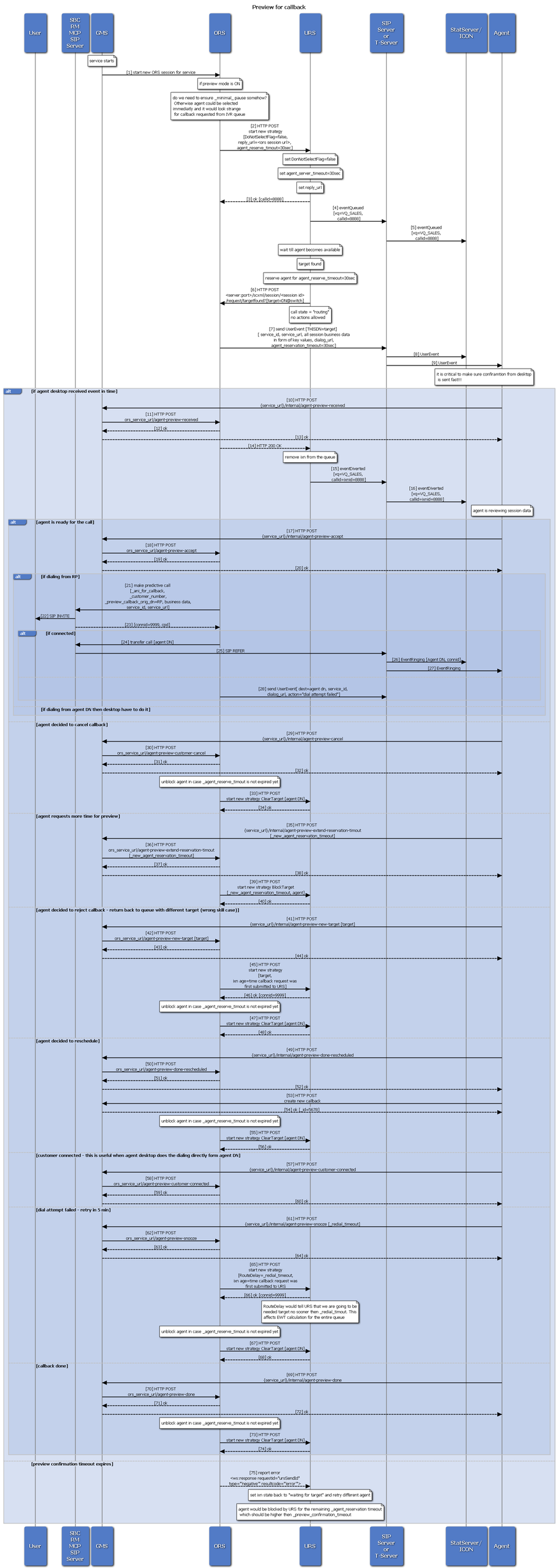Contents
User Terminated Delayed Agent Preview
Overview
This Callback scenario is an outbound service that goes through the following stages:
Start Callback
- Callback service: Returns session id to the user.
- Callback service: Waits for an agent to be available.
- Callback service: Reserves agent.
- Callback service: Sends preview invite to agent.
- Agent Desktop: Displays customer attached data with actions Accept and Cancel.
- Agent: Accepts the invitation by clicking the Accept button.
- Callback service: Receives the agent acceptance request.
- Callback service: Calls the mobile device from reserved agent's DN.
- Mobile device: Accepts the call.
- Callback service: Waits for interaction to be deleted.
- Callback service: Terminates after interaction is deleted.
Configuration Options
The table below lists the key options applicable to this scenario.
Use the GMS Service Management UI to set the configuration options. On the Services > Configured Services tab, add a Callback service with User-Terminated-Preview as the Common Default Configuration (see Adding a Service). When you add this service and default configuration, many options are automatically populated with the appropriate default values. Some options, however, will require you to enter your own values. See the Comments column in the following table for these details.
| Category | Option | Value | Comment |
|---|---|---|---|
| General | _call_direction | USERTERMINATED | These are the default values, which are automatically populated when using the pre-defined User-Terminated-Preview service. You do not need to change these values. |
| _media_type | voice | ||
| _wait_for_agent | true | ||
| _wait_for_user_confirm | false | ||
| URS Queuing | _target | <string> | You must enter a string value for this option. This option is the routing target that specifies the agent/queue resource that will process this request. Format the string according to the URS target specification:
<Target String>@<StatServer name>.<Target Type> Where Target Type is one of the following:
For example:
See the Universal Routing Server (URS) documentation for additional information about URS targets. |
| _urs_server_url | http://<urs primary hostname:port> | You must enter the URL for your primary Universal Routing Server (URS). | |
| _urs_virtual_queue | <virtual queue to be used by strategy> | You must enter the virtual queue to which the service request will be added. | |
| _urs_prioritization_strategy | WaitForTarget | The default value shown here matches the name of the URS strategy that you imported into IRD. If you changed the name of the strategy, update this value to reflect the correct name. | |
| _urs_strategy_update_sub_routine | SetRouteDelay | The default value shown here matches the name of the URS subroutine that you imported into IRD. If you changed the name of the subroutine, update this value to reflect the correct name. | |
| Voice-User Terminated | _prefix_dial_out | 9 | The options shown here are applicable for this scenario. You can use the default values, or you can set your own values (some of the options require you to set your own value). |
| _route_point | <value> | ||
| _userterminated_first_connect_party | AGENT | ||
| _agent_preview | true | ||
| _agent_preview_allow_reject | false | ||
| _agent_preview_timeout | 30 (seconds) | ||
| _cpd_enable | false | ||
| Voice Treatment | _treatment_call_failure_answering_machine | GMSApplications/<treatmentfile> | Enter the value shown here if you are using Genesys Media Server. If you are using a different media server, enter the path where you have placed your voice treatment files. |
| _treatment_find_agent_fail | GMSApplications/<treatmentfile> | ||
| _treatment_waiting_for_agent | GMSApplications/<treatmentfile> | ||
| _treatment_customer_connect | GMSApplications/<treatmentfile> |
Sample Request and Response Sequence
Request
URL:http://192.168.184.128:8080/genesys/1/service/callback/user_term_preview Request Method:POST Status Code:200 OK Request Headersview source Accept:application/json, text/javascript, */*; q=0.01 Accept-Encoding:gzip,deflate,sdch Accept-Language:en-US,en;q=0.8 Cache-Control:no-cache Connection:keep-alive Content-Length:513 Content-Type:multipart/form-data;boundary=AaB03x;charset=UTF-8 Cookie:JSESSIONID=1q2r9rzpkelzas5uh21vrubqd; BAYEUX_BROWSER=c397-1v94320p0gfmni2a3d4xs12mv gms_user:jdoe_desktop Host:192.168.184.128:8080 Origin:http://192.168.184.128:8080 Pragma:no-cache Referer:http://192.168.184.128:8080/genesys/admin/js/sample/cb/index.html User-Agent:Mozilla/5.0 (Windows NT 6.1; WOW64) AppleWebKit/537.36 (KHTML, like Gecko) Chrome/31.0.1650.57 Safari/537.36 Request Payload --AaB03x Content-Disposition: form-data; name="first_name" John --AaB03x Content-Disposition: form-data; name="last_name" Doe --AaB03x Content-Disposition: form-data; name="_provide_code" false --AaB03x Content-Disposition: form-data; name="_customer_number" 5125 --AaB03x Content-Disposition: form-data; name="location_lat" 37.8197 --AaB03x Content-Disposition: form-data; name="location_long" -122.4786 --AaB03x Content-Disposition: form-data; name="_device_os" comet --AaB03x Content-Disposition: form-data; name="_agent_preview_data" Field1Val, Field2Val,Field3Val,Field4Val --AaB03x
Response
HTTP/1.1 200 OK
{"_dialog_id":"0","_action":"ConfirmationDialog","_text":"You will receive a call from the agent","_ok_title":"Ok","_id":"440-f86e4dff-2c00-4753-a876-5b52354566de"}
Sequence Diagram
Click on the diagram to access full resolution.

